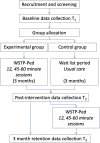Effectiveness of wheelchair skills training for improving manual wheelchair mobility in children and adolescents: protocol for a multicenter randomized waitlist-controlled trial
- PMID: 37752480
- PMCID: PMC10521483
- DOI: 10.1186/s12887-023-04303-8
Effectiveness of wheelchair skills training for improving manual wheelchair mobility in children and adolescents: protocol for a multicenter randomized waitlist-controlled trial
Abstract
Background: Self-directed mobility during childhood can influence development, social participation, and independent living later in life. For children who experience challenges with walking, manual wheelchairs (MWCs) provide a means for self-directed mobility. An effective MWC skills training program exists for adults, but controlled trials have not yet been documented in children and adolescents. This paper outlines the protocol for a multi-centre randomized wait-list controlled trial. The primary objective is to test the hypothesis that children and adolescents who receive MWC skills training will have higher MWC skills capacity compared to children and adolescents in the control group who receive usual care. The secondary objectives are to explore the influence of MWC skills training in children and adolescents (MWC use self-efficacy and satisfaction with participation in meaningful activities), and parents (perceived MWC skills); and to measure retention three months later.
Methods: A multi-centre, parallel-group, single-blind randomized wait-list controlled trial will be conducted. A sample of 60 children and adolescents who use MWCs will be recruited in rehabilitation centres, specialized schools, and the communities of three Canadian cities. Participants will be randomized (1:1) to the experimental (Wheelchair Skills Training Program [WSTP]) or wait-list control group (usual care). Performance-based and self-report measures will be completed at baseline (T1), three months (post-intervention, T2), and three months post-intervention (T3). The primary outcome will be MWC skills capacity post-intervention. Secondary outcomes will be MWC use self-efficacy and satisfaction with participation of the child/adolescent, and parent-perceived MWC skills. The WSTP will consist of 12 sessions, 45-60 min each, delivered 1-2 times per week by trained personnel with health professions education. Training will be customized according to the child's baseline skills and participation goals that require the use of the MWC. The wait-list control group will receive usual care for 3 months and then receive the WSTP after completing T2 evaluations. Data will be analysed using ANCOVA (controlling for baseline scores).
Discussion: MWC skills training may be one way to improve self-directed mobility and related outcomes for children and adolescents. The results of this multi-centre randomized wait-list controlled trial will allow for the effectiveness of the intervention to be evaluated in a variety of clinical contexts and geographical regions.
Trial registration: ClinicalTrials.gov: NCT05564247, Version October 3, 2022.
Keywords: Adolescents; Children; Disability; Manual wheelchair; Participation; Wheelchair skills training; Youth.
© 2023. BioMed Central Ltd., part of Springer Nature.
Conflict of interest statement
The authors declare no competing interests.
Figures
Similar articles
-
Exploring the influence of a school-based wheelchair skills training program on manual wheelchair mobility in youth: an exploratory study.Disabil Rehabil Assist Technol. 2025 Aug;20(6):1748-1754. doi: 10.1080/17483107.2025.2483297. Epub 2025 Mar 25. Disabil Rehabil Assist Technol. 2025. PMID: 40132014
-
Pilot Study of a Peer-Led Wheelchair Training Program to Improve Self-Efficacy Using a Manual Wheelchair: A Randomized Controlled Trial.Arch Phys Med Rehabil. 2016 Jan;97(1):37-44. doi: 10.1016/j.apmr.2015.08.425. Epub 2015 Sep 4. Arch Phys Med Rehabil. 2016. PMID: 26343171 Clinical Trial.
-
Effect of a Community-Based Peer-Led eHealth Wheelchair Skills Training Program: A Randomized Control Trial.Arch Phys Med Rehabil. 2025 Jun;106(6):821-827. doi: 10.1016/j.apmr.2024.12.011. Epub 2024 Dec 19. Arch Phys Med Rehabil. 2025. PMID: 39709023 Clinical Trial.
-
Effectiveness of the Wheelchair Skills Training Program: a systematic review and meta-analysis.Disabil Rehabil Assist Technol. 2019 May;14(4):391-409. doi: 10.1080/17483107.2018.1456566. Epub 2018 Apr 4. Disabil Rehabil Assist Technol. 2019. PMID: 29616832
-
Comparison between performance with a pushrim-activated power-assisted wheelchair and a manual wheelchair on the Wheelchair Skills Test.Disabil Rehabil. 2006 Feb 28;28(4):213-20. doi: 10.1080/09638280500158448. Disabil Rehabil. 2006. PMID: 16467056 Review.
Cited by
-
Exploring Physical Activity in Children and Adolescents with Disabilities: A Bibliometric Review of Current Status, Guidelines, Perceived Barriers, and Facilitators and Future Directions.Healthcare (Basel). 2024 May 1;12(9):934. doi: 10.3390/healthcare12090934. Healthcare (Basel). 2024. PMID: 38727491 Free PMC article. Review.
References
-
- Wheelchair provision guidelines. Geneva: World Health Organization; 2023. Licence: CC BY-NC-SA 3.0 IGO. - PubMed
Publication types
MeSH terms
Associated data
Grants and funding
LinkOut - more resources
Full Text Sources
Medical


